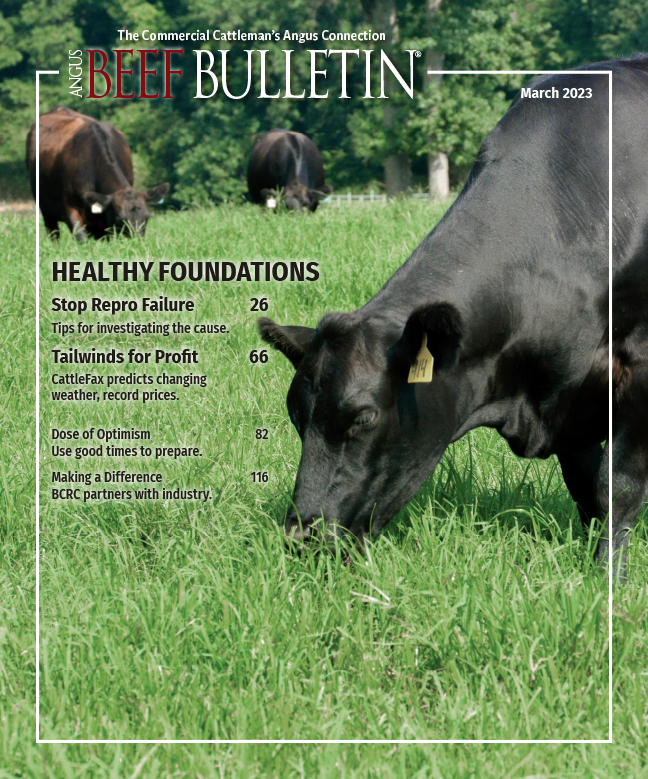
Pain Management in Cattle: Drug Dilemma
With few pain-relief drugs on the market for cattle, producers and veterinarians must know their options.
Hans Coetzee, distinguished professor and head of the Department of Anatomy and Physiology at the Kansas State University College of Veterinary Medicine, has been working with pain-management issues for the livestock industry for more than 10 years. “One of the challenges in the U.S. is the lack of drugs specifically approved by the FDA (Food and Drug Administration) for pain relief in food animals,” he says.
“One drug, Banamine® Transdermal, was approved for pain management in 2017. Although it is very effective, it is only labeled for relief of pain associated with foot rot in beef cattle and, as of January 2023, dairy cattle. We are very limited in our ability to provide pain management to food animals for other painful conditions, such as castration and dehorning,” says Coetzee.
Because there are no specific approvals for managing pain associated with dehorning and castration, producers often use a drug in an extra-label manner, says Coetzee. This means it’s not specifically labeled for a certain purpose and can be prescribed by a veterinarian.
Extra-label drug use (ELDU) is governed by the Animal Medicinal Drug Use Clarification Act (AMDUCA). This Act allows for extra-label use of drugs under direction of a prescription by a veterinarian in situations where there are no other drugs approved for that purpose and where the animal’s health is threatened or the animal is suffering. The law is a framework producers and veterinarians use to provide pain management in food animals for conditions where no drug approvals currently exist.
The challenge with ELDU is that the veterinarian is responsible for ensuring that the animal(s) receiving a drug in an extra-label way does not pose a risk to consumers in terms of drug residues in meat or milk, explains Coetzee. “The veterinarian must provide the producer with withdrawal-period recommendation.”
Use of a drug extra-label depends on a valid veterinarian-client-patient relationship (VCPR) and an understanding of how the drug is to be used. This includes route of administration, dosage, withdrawal period, etc.
“Today our industry recognizes importance of the VCPR to provide the regulatory foundation for a practitioner to work with the producer to provide medications for extra-label use when considered necessary,” he says. Certain animals can then benefit from receiving pain relief and can be marketed afterward without risk of tissue residues.
Meloxicam, a nonsteroidal anti-inflammatory medication for human arthritis, has been approved for use in food animals in Canada for several years, but it is not yet approved for that use in the United States, says Coetzee. “However, ELDU of generic meloxicam tablets for humans can legally occur in food animals to relieve pain and suffering, provided there are no FDA-approved drugs specifically labeled for this purpose.”
“Oral meloxicam tablets are a relatively inexpensive way to provide pain relief in cattle under the direction of a veterinarian and in compliance with AMDUCA,” he says. “A potential challenge for the producer, however, is how to deliver the drug. Since meloxicam comes in small tablets intended for humans, this may not be the most efficient way to provide it to cattle. Most producers would prefer a large oral bolus, an oral liquid suspension, injection or topical administration for a pain-relief drug.”

Because there are no specific approvals for managing pain associated with dehorning and castration, producers often use a drug in an extra-label manner. [Photo by Heather Smith Thomas] |
There are plenty of opportunities for pharmaceutical companies to invest in new pain relief drugs and novel formulations with more convenient routes of administration, notes Coetzee.
Measuring pain
One challenge for pharmaceutical companies in gaining approval for pain-relief drugs is that FDA requires a validated method of pain assessment in animals to approve the drug. It has been difficult for companies to come up with pain assessment methods that would satisfy the FDA.
“There have been several attempts at developing pain scales and pain-scoring systems in food animals, but one of the challenges has been to validate them in a way they can be used objectively by the drug company or the producer to confirm that the animal is in pain and that the drug is actually working,” describes Coetzee.
One of the current pain detection tools assesses how an animal walks using a pressure mat. The pressure mat detects force changes, surface area, stride length and foot pressure when the animal walks on the mat. Each footfall is visualized, and specialized software characterizes the animal’s gait before and after a painful procedure, he says. Painful conditions, such as lameness, castration and calving, can change the way an animal walks, which can be detected and measured on the pressure mat.
“The pressure mat can be used as a validated method of pain assessment to determine whether a drug is working or not. This technology was an important component of the studies conducted for approval of Banamine Transdermal, because the company was able to show that with foot rot the animals that received the pain relief drug applied more force and area on the affected foot — walking more normally,” he explains.
Editor’s note: Heather Smith Thomas is a freelance writer and a cattlewoman from Salmon, Idaho. [Lead photo by Shauna Hermel]



